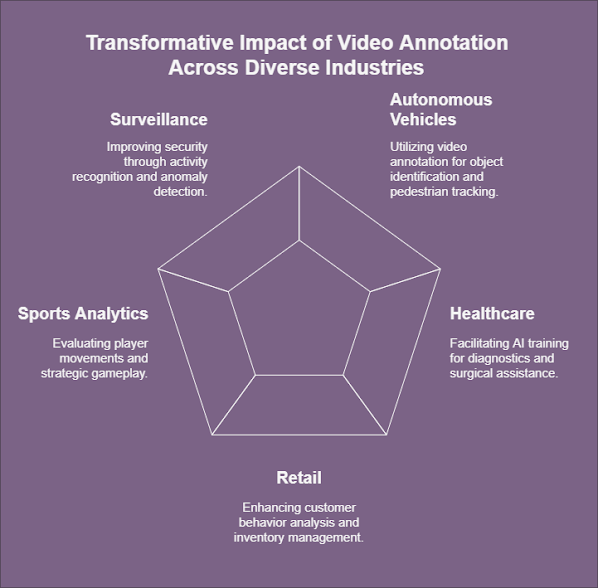Video Annotation for AI: Tools, Techniques, and Best Practices

Introduction:
As the field of artificial intelligence (AI) progresses, Video Annotation Services has become an essential procedure for training machine learning models, especially in computer vision applications. From self-driving cars to security monitoring systems, video annotation allows AI technologies to comprehend, analyze, and react to ever-changing visual contexts. This article delves into the tools, methodologies, and optimal practices that facilitate efficient video annotation for AI.
Defining Video Annotation
Video annotation refers to the practice of labeling video content to train AI models in recognizing and interpreting various objects, actions, and situations depicted in the footage. Annotated videos play a vital role in tasks such as object detection, motion tracking, activity recognition, and semantic segmentation. By meticulously tagging components within video frames, developers can generate datasets that enable AI systems to make well-informed decisions in practical scenarios.
Various tools and platforms are available to enhance the video annotation process. These solutions provide functionalities such as frame-by-frame annotation, object tracking, and collaborative workflows. Below are several notable options:
Labelbox
- An intuitive platform designed for annotating both videos and images.
- Includes automation capabilities to expedite the annotation process.
- CVAT (Computer Vision Annotation Tool)
- An open-source tool that is highly customizable.
- Supports various annotation types, including bounding boxes, polygons, and 3D cuboids for video content.
V7 Darwin
- Emphasizes AI-assisted video annotation.
- Equips users with tools for developing intricate annotations such as segmentation and tracking.
SuperAnnotate
- Merges AI-driven tools with features for collaborative annotation.
- Well-suited for extensive annotation projects.
Amazon SageMaker Ground Truth
- Provides both automated and human-in-the-loop annotation workflows.
- Offers seamless integration with AWS, facilitating scalable AI initiatives.
Techniques for Video Annotation
A variety of techniques can be utilized for video annotation, tailored to the requirements of the AI model and the specific use case:
Frame-by-Frame Annotation
- This method involves annotating each frame individually to achieve a high level of accuracy.
- It is particularly suitable for tasks that demand precise object detection and tracking.
Keyframe Annotation
- This approach focuses on annotating selected keyframes and using interpolation to fill in annotations for the frames in between.
- It accelerates the annotation process for videos where object movement is minimal.
Polygon Annotation
- This technique involves outlining irregular shapes around objects to achieve pixel-perfect accuracy.
- It is frequently employed in tasks related to semantic segmentation.
3D Cuboid Annotation
- This method entails annotating objects in three dimensions to accurately represent depth and volume.
- It is crucial for applications such as autonomous driving.
Object Tracking
- This technique involves tracking objects across multiple frames through algorithms, thereby minimizing manual input.
- It improves efficiency while ensuring the quality of annotations is upheld.
Best Practices for Video Annotation
Successful video annotation necessitates a combination of technical skills, rigorous quality control, and streamlined workflows. The following best practices should be taken into account:
Establish Clear Objectives
- Identify the goals of the annotation and the specific attributes that the AI model is intended to learn. This approach guarantees that annotations remain focused and pertinent.
- Utilize Pre-Annotated Models
- Make use of AI-driven annotation tools capable of automatically labeling video components, which can subsequently be adjusted manually to enhance accuracy.
Develop Annotation Guidelines
- Formulate a uniform set of standards for annotators to adhere to, encompassing labeling formats, definitions of objects, and exceptional cases.
Emphasize Quality Assurance
- Adopt a review mechanism to verify the accuracy and consistency of annotations. Peer evaluations and automated validation tools can be beneficial in this regard.
Implement Collaborative Workflows
- Distribute annotation responsibilities among teams and employ cloud-based platforms to facilitate coordination and optimize efforts.
Prioritize Data Diversity
- Ensure that the dataset encompasses a wide range of scenarios, lighting conditions, and object types to enhance the model’s ability to generalize.
Integrate Feedback Loops
- Continuously improve the annotation process by incorporating insights from the AI model’s performance.
Video annotation serves a diverse array of purposes across various sectors:

- Autonomous Vehicles: Utilizing video annotation for the identification of objects, lane markings, and tracking pedestrians.
- Healthcare: Facilitating the training of artificial intelligence for diagnostics based on video analysis and assistance during surgical procedures.
- Retail: Improving the analysis of customer behavior and optimizing inventory management.
- Sports Analytics: Evaluating player movements, actions, and strategic gameplay.
- Surveillance: Enhancing security measures through activity recognition and the detection of anomalies.
Conclusion
Video annotation is fundamental to numerous advanced AI applications. By utilizing appropriate tools, implementing effective methodologies, and following best practices, Globose Technology Solutions organizations can develop high-quality datasets that enable AI models to execute intricate visual tasks. Whether the goal is to create an autonomous vehicle or to transform healthcare diagnostics, investing in comprehensive video annotation processes will yield significant benefits in the form of precise and dependable AI systems.



Comments
Post a Comment